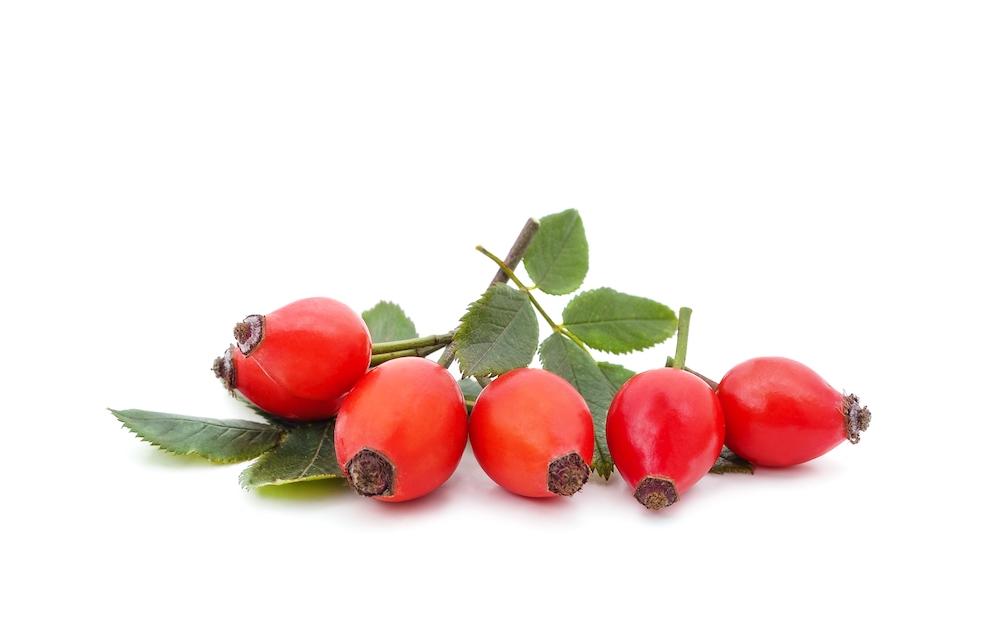Rose Hip

Rose hips (Rosae fructus) are the accessory fruits of various species of wild rose. These bright red fruits with a tangy citrus taste are really something. They contain lots of vitamins, minerals, and trace elements, boost the immune system, promote metabolism, and can relieve joint pain.
Where do rose hips come from, and what do they look like?
In autumn, European hedgerows and sunny edges of forests become ablaze with the red fruits of various wild varieties of the rose family (Rosaceae). The German name, Hagebutte, comes from the old Germanic word "hag", meaning hedge or bush. All rose species generally bear accessory fruits. However, rose hips can only be found on certain wild rose species. These include the dog rose – (Rosa canina L.), the alpine or mountain rose (Rosa pendulina L.), the Gallic rose (Rosa gallica L.) and the Provence or cabbage rose (Rosa x centifolia L.). The fruits of the apple rose are considerably larger and thus more yielding than the smaller fruits of other wild rose species.
The genus "Rosa" comes from Eurasia, presumably from Central Asia, where the native strains of most cultivated roses originated. Wild rose varieties are basically characterised by shrubby growth, with single-flowered blossoms with five petals and numerous stamens. Consumption of the fruits by birds, rodents, and other animals disseminated this sun-loving hedge plant around the entire northern hemisphere. Its range extends from the Arctic tree line in the north to tropical mountain regions in the south, where only a few species grow. There are between 120 and 250 species of wild rose, depending on sources. By contrast, there are close to 30,000 different varieties of cultivated roses. Some robust species can grow at elevations of 3,000 metres. One of the oldest rose cultivation sites is found at 2,000 metres in the Al-Hajar Mountains in northern Oman.
One of the most common rose species found in Central Europe is the dog rose. It grows on an upright stem to approximately two to three metres at elevations of up to 1,700 metres. It forms extensive hedges with its fast-growing, arching, prickly branches and twigs. All wild roses bear thorns. Most types of roses have prickles that are strong and hook-shaped. They protect the plant from predators and help it to climb. Some types, like the dog rose, cast off their feathery foliage in winter. In early summer, the shrub will have many pink or white blossoms. Its flowering period is short, from May to June. Dog roses are only slightly fragrant and also have no nectar. However, they produce large quantities of pollen. Other wild rose species, for example the Gallic rose, bloom from June to July, have captivating scents, and are good for bees.
After pollination, the free-standing ovary ripens into an accessory fruit with a fleshy calybium and cupule. This contains the actual fruits, which appear as rock-hard, jagged, bristly seeds. The bald, ovoid to spherical accessory fruits are bright red and are called rose hips. These don't ripen until late in the year. They are often red by September, but do not completely ripen until October or November. Today, large-scale rose hip cultivation is found in Eastern Europe, Russia, China, and Chile.
How are rose hips used?
Rose hips are harvested for rose hip tea in sunny, dry weather, when they are bright red and still hard.
Tip: Wear gloves when picking and handling rose hips! Their branches are quite thorny and have fine hairs that can cause itching.
The fruits are cut lengthwise and dried gently at max. 40 °C. They should then be stored in a cool, dark place. Rose hip tea is especially popular during the winter cold seasons due to its high amount of vitamin C. The seeds embedded in the flesh of the fruit also contain a fatty oil which is commercially available as wild rose oil and is often used in cosmetics. The European Scientific Cooperative on Phytotherapy (ESCOP) recommends rose hips and rose hip peels to help treat colds and flu as well as to help treat arthritis-related joint pain and stiffness. In folk medicine, rose hips are used to treat fever, diseases of the kidney and bladder, gout, and rheumatism. Rose hip purée is administered as a tonic and energy booster. Rose hip powder has analgesic, anti-inflammatory, and antioxidant effects. A Danish research group studied rose hip powder's effects in treating osteoarthritic ailments. It noted an increased joint mobility and a 44% reduction in consumption of painkillers. Rose hip powder's positive effect in nutritional therapy was confirmed by further studies at the University of Copenhagen.
A temperature of 40 °C should not be exceeded when producing rose hip powder in order to retain its galactolipids. Processing involves both the pulp and the seeds – only the irritating little hairs are removed. We may well remember the latter from our childhood days as itching powder. Fresh rose hips can be boiled down to produce purée, jam, jelly, or juice. Humans should not eat them raw. The cooked fruits have a sweet-sour, aromatic taste. Freshly prepared rose hips have the highest amounts of active substances. These, however, are quickly degraded through strong heating and prolonged cooking, especially vitamin C. Although vitamin C is heat-stable in crystalline form up to 190 °C, in water solutions it oxidises to form dehydroascorbic acid, which is rapidly degraded by hydrolysis. Additional exposure to heat speeds up the process, which is why drinks containing vitamin C should not be heated too much or for too long. This is why hot lemonade, a popular winter drink, is normally served no hotter than 60 °C.
To extract the oil, the fruits are harvested as soon as they are fully ripe. The clear, yellow-orange rose hip oil is obtained by pressing the hard seeds or through extraction. It is mainly used in cosmetic and skin treatment products. It nourishes cracked and flaky skin and is also used to relieve eczema, psoriasis, and in scar treatment. In cosmetics, it is frequently found in products for ageing, distressed skin. Its all-trans retinoic acid accelerates the skin's regeneration process. It is used in some countries to treat gum and mouth wounds. Rose hip oil should be kept away from light, however, as it will oxidise quickly. It is often used in cosmetics to make nourishing night creams. For dogs and horses, rose hip oil's omega-3 fatty acids are beneficial to the skin and coat.
What are the active substances in rose hips?
Rose hips are little vitamin bombs. Rose hips have the highest vitamin C content of all native fruits – about 20 times that of a conventional lemon.
Important: The vitamin C in rose hips will decay if stored improperly or for too long. Observe manufacturer instructions for commercial preparations.
Dogs and horses can make vitamin C from glucose in the liver, but an increased vitamin C requirement, for example from athletic performance, stress, pain, infections, or old age cannot be covered by synthesis in the body. Vitamin C is an antioxidant and boosts the immune system. It also plays an important role in the formation of collagen in connective tissue and the building of bones and cartilage. Vitamin C is also an important component of the body's synthesis of carnitine, which is essential for building muscle. Rose hips also contain the red pigment lycopene, an antioxidant which is considered a free radical scavenger. Rose hips are also rich in provitamin A, which the body turns into vitamin A, as well as B vitamins and minerals like iron, selenium, and manganese, and trace elements like copper and zinc.
Its other substances include malic acid, citric acid, flavonoids, carotenoids, pectin, tannins, minerals, and sugar. It also contains galactolipids which demonstrate antioxidant and anti-inflammatory effects. These substances are especially effective in treating chronic joint diseases. The acids contained in rose hips regulate digestion and stimulate urine production. They support the kidney and bladder and help the organism to eliminate harmful substances. Pectin has soothing effects on stomach problems and promotes the regeneration of irritated stomach linings. Tannins are effective in treating diarrhoea. Flavonoids are secondary plant substances which protect the organism from bacteria and viruses.
What can rose hips be used to treat in horses and dogs?
Rose hips are packed with vitamins. The active substances in rose hips can boost the body's defences in times when the organism is particularly strained, such as during the moulting period, after an illness, or during stress. The immune systems of older dogs and horses can be given a long-term boost from the vitamin-rich and antioxidant properties of rose hips.
Tip: For a strengthening rose hip purée for horses, remove the pits and hairs of ripe rose hips and purée, mixing 1-to-1 with honey. Stir a teaspoon of the purée into your horse's feed.
Rose hips are high in vitamin C, vitamin B3, and provitamin A, all beneficial for building muscle.
Scientific studies show that rose hip peels stimulate metabolism, promote blood circulation, and have anti-inflammatory properties. Rose hips can be fed preventively to horses with increased risk of laminitis due to chronic metabolic disorders (PSSM, EMS).
Rose hips can help to alleviate symptoms in horses and dogs with degenerative joint diseases (arthrosis), increasing vitality.
Tip: Most horses like dried rose hops and will enjoy them as a healthy, low-sugar treat or mixed in with their feed (max. 100 g per 500 kg of body weight). Some horses will also nibble on fresh rose hips right off the plant!
Adverse effects:
Side effects from feeding rose hips and rose hip preparations are quite rare. Their tannins may cause gastrointestinal ailments in sensitive animals.
Sources
- Cäcilia Brendieck-Worm, Matthias F. Melzig: Phytotherapie in der Tiermedizin, Thieme 2018
- S. Krist, G. Buchbauer, C. Klausberger: Lexikon der pflanzlichen Fette und Öle, Springer-Verlag 2008
- Arthrose: Hagebuttenpulver lindert Gelenksbeschwerden
- https://www.pharmazeutische-zeitung.de/ausgabe-062007/hagebutte-auf-dem-pruefstand/
- https://www.deutsche-apotheker-zeitung.de/daz-az/2006/daz-24-2006/uid-16041
- https://de.wikipedia.org/wiki/Hagebutte
- http://www.pharmawiki.ch/wiki/index.php?wiki=Hagebutte
- http://www.koop-phyto.org/arzneipflanzenlexikon/hagebutte.php
- http://www.pharmawiki.ch/wiki/index.php?wiki=Hagebuttenpulver
- http://www.biologie-schule.de/hagebutte.php
- https://www.apotheken.de/news/8318-viel-heisse-luft-um-die-heisse-zitrone
- https://www.chemie.de/lexikon/Ascorbins%C3%A4ure.html













